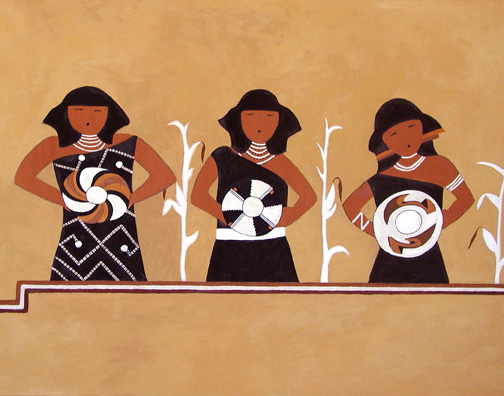
Reproduced in oil paint by Thomas Baker
Thomas Baker Paintings Home Page

The Singing Maidens of Pottery Mound
Reproduction of an Anasazi Indian kiva mural from Pottery Mound, New Mexico, by Thomas Baker
(original approx. 800 years old)
36 X 40 inches, oil paint on plaster-textured wood panel
This painting is available for purchase: $6500 - Contact Thomas Baker
Prints of this painting are also available--click here for prices and ordering info
|
On the desolate banks of the Rio Puerco (“Pig “or “Dirty” River), a tributary of the Rio Grande in central New Mexico, is an archaeological site known as Pottery Mound, so named for the profusion of ancient pottery fragments scattered about the ground over several acres (in fact it is hardly possible to walk around the site without stepping on shards of ancient decorated pottery). Here in the late 1950’s and early 60’s the Archaeological Field School of the University of New Mexico, under the direction of archaeologist Dr. Frank Hibben, excavated a series of subterranean rooms or kivas upon whose walls were a found a remarkable series of murals depicting the life and ceremonies of a long-vanished people. The one-time inhabitants of Pottery Mound, who began living there perhaps 800 years ago, are classified as a prehistoric or Stone Age culture because no evidence of writing or metals has been found there. They lived in crude communal apartment complexes constructed of adobe mud. These were a farming people in a semi-desert land, whose religion was oriented toward the bringing of precious rain to their crops of corn, beans, squash, and possibly also the cotton from which their textiles were woven. There is evidence of ritual human sacrifice in some of the murals, and some archaeologists have also interpreted the fragmentary human bone scattered about the mound as evidence of cannibalism (see my painting “Anasazi Kitchen” on my website thomasbakerpaintings.com, or the print of it available on Ebay). Pottery Mound was a thriving community from about AD 1200 to 1475, but had been abandoned by the time Europeans (Spanish) first entered the area in 1540. The painting shows three Anasazi Indian women, surrounded by corn plants, apparently singing while holding baskets made of plant fibres with elaborately woven designs. Archaeologists have speculated that this mural represents a corn harvest, and the women may be singing harvest songs, or they may have been participating in a ceremony intended to bring rain. In the original mural there were four maidens, but one was so badly damaged she was difficult to reconstruct, and has been left out here. The three maidens shown, and the corn plants between them, were also painted somewhat further apart in the original than you see them here, and in this composition I have moved them a little closer together in order to fit them into a reasonably sized image. I also reconstructed the basket design on the central maiden, which was quite fragmentary, but I am confident it is as close as possible to the original design. The Pottery Mound artists painted their murals on walls of whitewashed adobe, or mud plaster, using paints made from ground earths, charcoal, and vegetable dyes of various colors mixed into a medium of water and/or animal fat grease. It was applied either with the fingers or with a brush made by chewing the end of a slender yucca leaf until it was soft and pliable. The murals were painted in layers on the walls of the underground rooms, one painting atop another over a period of possibly years, so that during the archaeological work each layer had to be removed to expose the paintings beneath it. This necessarily destroyed the paintings as the work progressed, leading Dr. Hibben to eventually halt the work until some means could be found to lift the murals off intact and preserve them. Hibben estimated that 80 percent of the paintings of Pottery Mound are still under the ground at the site, undisturbed, a fabulous ancient art treasure still awaiting discovery. To create this painting I first analyzed photographs of the original, fragmentary mural and then reconstructed it as closely as the evidence allowed. I painted it using oil paints on a wooden panel that I first coated with a special plaster to replicate the texture of the original walls of the ancient kiva. The modern earth colors were mixed so as to duplicate as closely as possible the original earthtones of the ancient artist’s palette. Dr. Hibben authored a book about the Pottery Mound murals published in 1975 entitled “Kiva Art of the Anasazi at Pottery Mound” (KC Publications of Las Vegas, Nevada). The word Anasazi is a Navajo Indian term usually translated as “The Ancient Ones” (although it more accurately means “ancient enemies”). Of his book Dr. Hibben wrote: “Its primary purpose is to present these paintings to the world. Explorations of the ethnological, ritualistic, and artistic content of the paintings will be left to scholars whose expertise lies in those fields, and it will undoubtedly take many years for them to draw reliable conclusions from this wealth of material. It is indeed fortunate that, with this rare opportunity to see and examine these remarkable works of long-dead and nameless artists, such studies can now be pursued” (Introduction, p. xiii). |
Return to Prehistoric Painting Reproductions
Thomas Baker Paintings Home Page
Original paintings by Thomas Baker Group 1 | Group 2 | Group 3 | Group 4
Portraits | Old Masters copies | Ancient civilizations reproductions | Prehistoric reproductions
About the Artist | Contact Thomas Baker